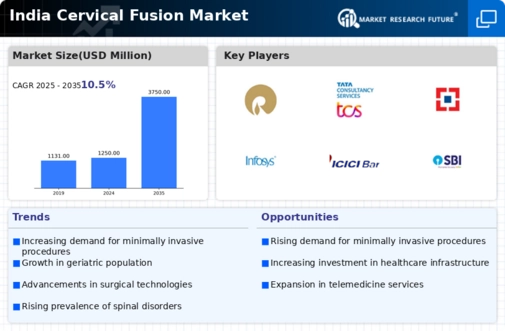Rising Healthcare Expenditure
The increase in healthcare expenditure in India is a significant driver for the cervical fusion market. With the government's commitment to enhancing healthcare infrastructure and services, the overall spending on health is expected to rise. Reports indicate that healthcare expenditure as a % of GDP is projected to reach 3.5% by 2025, reflecting a growing focus on improving access to quality medical care. This increase in funding is likely to facilitate the availability of advanced surgical options, including cervical fusion procedures, making them more accessible to patients. Additionally, the expansion of health insurance coverage is expected to alleviate the financial burden on patients, further driving demand for cervical fusion surgeries. As healthcare investments continue to grow, the cervical fusion market is poised for expansion, catering to the needs of a larger patient population.
Increasing Geriatric Population
The growing geriatric population in India is a crucial driver for the cervical fusion market. As individuals age, they often experience degenerative spinal conditions, necessitating surgical interventions such as cervical fusion. According to recent demographic data, the population aged 60 and above is projected to reach approximately 300 million by 2030, which represents a significant segment of the population likely to require cervical spine surgeries. This demographic shift indicates a rising demand for effective treatment options, thereby propelling the cervical fusion market forward. Furthermore, the increasing life expectancy in India, which is currently around 70 years, suggests that more individuals will seek surgical solutions for age-related spinal issues. Consequently, the cervical fusion market is expected to expand as healthcare providers adapt to the needs of this aging population.
Growing Awareness of Spinal Health
There is a notable increase in awareness regarding spinal health among the Indian population, which is positively influencing the cervical fusion market. Educational campaigns and initiatives by healthcare professionals are emphasizing the importance of early diagnosis and treatment of spinal disorders. This heightened awareness is leading to more individuals seeking medical advice for cervical issues, resulting in an uptick in diagnoses and subsequent surgical interventions. Furthermore, the proliferation of information through digital platforms is enabling patients to understand their conditions better and explore treatment options. As awareness continues to grow, it is likely that more patients will opt for cervical fusion surgeries, thereby driving market growth. The cervical fusion market stands to benefit from this trend as healthcare providers respond to the increasing demand for spinal health services.
Advancements in Surgical Techniques
Innovations in surgical techniques are transforming the landscape of the cervical fusion market. Minimally invasive procedures, such as endoscopic cervical discectomy and robotic-assisted surgeries, are gaining traction among surgeons due to their potential to reduce recovery times and improve patient outcomes. These advancements not only enhance the precision of surgical interventions but also minimize complications associated with traditional open surgeries. As a result, hospitals and surgical centers in India are increasingly adopting these modern techniques, which could lead to a rise in the number of cervical fusion procedures performed annually. The market is likely to benefit from the growing acceptance of these advanced methodologies, as they align with the broader trend of improving surgical efficiency and patient satisfaction in the healthcare sector.
Technological Integration in Healthcare
the integration of technology in healthcare has emerged as a pivotal driver for the cervical fusion market. The adoption of telemedicine, electronic health records, and advanced imaging techniques is enhancing the efficiency of patient care and surgical planning. In India, the use of telemedicine has surged, allowing patients to consult specialists remotely, which can lead to timely interventions for cervical disorders. Additionally, advanced imaging technologies, such as MRI and CT scans, are improving diagnostic accuracy, enabling healthcare providers to make informed decisions regarding surgical options. This technological integration not only streamlines the patient journey but also fosters a more effective approach to cervical fusion procedures. As healthcare systems continue to embrace these innovations, the cervical fusion market is likely to experience growth driven by improved patient outcomes and operational efficiencies.

















Leave a Comment